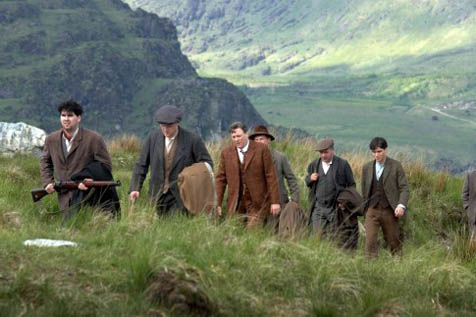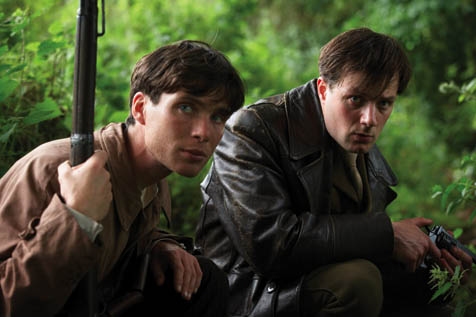An Interview with Paul Laverty, Screenwriter of The Wind That Shakes the Barley
All Shook Down

Paul Laverty’s biography is not that of your typical screenwriter-born to an Irish mother and Scottish father in Calcutta, he obtained a philosophy degree in Rome and a law degree in Scotland. He put his legal expertise to use in Central America in the 1980s, working closely with domestic human rights organizations during the Nicaraguan civil war and also traveling to El Salvador and Guatemala. During the mid 1990s, Laverty turned his interest in social issues into cultural practice, initiating a decades-long collaboration with legendary English filmmaker Ken Loach, resulting in a string of successful collaborations, as well as Laverty winning the best screenplay award at Cannes for 2002’s Sweet Sixteen.
Their 2006 collaboration, The Wind That Shakes the Barley, is a historical drama about two brothers, Damien (Cillian Murphy) and Teddy (relative newcomer P¡draic Delaney), whose lives are torn apart by the relentless violence visited upon the Irish by British Black and Tan soldiers in 1920 and their differing ideas of how to respond to such brutality. The film was awarded the Palme d’Or (the top prize at Cannes). The exceedingly busy Laverty was kind enough to answer questions and was open to discussions about the film’s violence, historical accuracy, and critical reception.
Much of the general criticism of The Wind That Shakes the Barley focused on whether the film was historically accurate. How important is the historical element to you when writing? It was very important to me that the historical details were correct. Given the subject matter, I knew opponents would go through it with a fine-tooth comb, and I am very glad to say there is nothing they could point to as inaccurate. Therefore, most critics tried to trash the film via personal insults directed at the makers of the film. Many right-wing critics attacked the film without having the opportunity of seeing it first, which did cause us much amusement. At the heart of the film is the U.K. government’s determination not to recognize the democratic mandate of the Irish people for independence from the British Empire, as demonstrated in the 1918 election result. Sinn Fein, the nationalist party, won 73 out of 105 seats. They won the election clearly. When the result wasn’t respected and they demonstrated [in protest], they were thrown in jail. : So this film challenged the stereotype of the civilizing nature of the British Empire and its so-called respect for the rule of law. : Empires lie about themselves. I suppose if you lie about the past it’s much easier to lie about the present.

What more is to be learned from the violence in the film, beyond the simple fact that violence begets violence? The Black and Tans were in fact much more violent than we could possibly portray in the film. No historian has ever challenged that. It would have been fascinating to tell the story from the point of view of young British soldiers. They themselves were brutalized in the First World War, [then] sent back to the U.K. and unemployment. Little wonder it was easy to recruit them to terrorize the Irish, which of course was their sole function since they had no police experience. I think it would be easy to simply say violence begets violence. It is important to try and untangle it all and find the roots of it. Again, I saw this in Nicaragua and El Salvador in the ’80s. The victims were traumatized and, in my experience, many of those who are violent suffer, too. I met many young men traumatized by what they had done. I think this is a phenomenon of many wars.
What specifically drew you to the subject matter of the film, both in the sense of its meaning for modern-day conflicts, as well as a portrayal of a historical past that is still politically relevant to the present day? I started writing this story before the disgraceful events of Iraq began. Many thought we planned it as some sort of metaphor. In fact, we tried to be totally faithful to the events and circumstances of March 1919.
But, of course, while technology and exact circumstances change, there is a great deal about the phenomena and psychology of a war of occupation that has many parallels that began to amaze me. Even the rhetoric of justification and the attempt to take the high moral ground to justify the occupation struck me as very similar. At one point David Lloyd George [who was the British prime minister during the time the film is set] said, “We have murder by the throat!” while at the same time they were torturing and murdering. Sound familiar?
Was it important to have a well-known, charismatic actor such as Cillian Murphy onscreen for the lead character, or was his casting more incidental? It might not be apparent to a foreign audience, but every accent in the film is true to the very particular area in which we filmed and where, in fact, the greatest amount of resistance to U.K. rule took place: County Cork. : Cillian comes from the city of Cork. We chose him not because he was a star, but because he is a brilliant actor and of course his accent fit in perfectly with his character.
Did you feel drawn to screenwriting because you felt you could reach a wider audience and bring more attention to issues that were important to you? Choosing the subject matter, the characters and premise to a story, and how we attempt to tell it reveals a great deal about the filmmakers. Our choice of material is of course affected by our values, politics, and how we see the world. It strikes me that a great many contemporary films glorify the pursuit of wealth, romanticize violence, and usually set up “Western values” as superior. It’s often simplistic and very crude; black and white. In the end, it makes for a spectacular lie about how Westerners see themselves. They lie to the rest of the world, too. I have zero interest or respect for this type of filmmaking, no matter where it comes from.
4•1•1
The Wind That Shakes the Barley screens as part of UCSB’s Arts & Lectures series on Wednesday, August 1, at 7:30 p.m. Tickets are $6 general admission, $5 for UCSB students.



